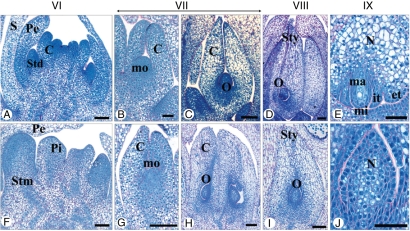Fig. 6.
Development of the gynoecium in pistillate and staminate flowers. (A–E) Sexual differentiation and maturation of the fertile gynoecium in pistillate flower. (A) Carpel primordium initiation at stage VI. (B) Elongation of carpel primordium at stage VII. (C) Ovule initiation revealing the presence of proximal/distal symmetry at stage VII. (D) At stage VIII, the carpel primordium is elongated, the external integuments are formed and the ovule occupies an anatropous position. (E) Detail of ovule at stage IX. The internal integuments are formed and the macrospore remains in a premeiotic state. (F–J) Development of sterile gynoecium (pistillode) in staminate flower. (F) At stage VI, the pistillode primordium in the staminate flower shows weak growth. (G) At stage VII, the pistillode primordium has elongated and ovular meristem is initiated. (H) At stage VIII, the nucellus is initiated in the ovule of the pistillode. The carpel shows a proximal/distal symmetry. (I,J) At stage IX, pistillodes display a developed nucellus (I). (J) Detail of ovule in pistillodes. Abbreviations: C, carpel; et, external integument; it, internal integument; mi, micropyle; mo, ovular meristem; ma, macrospore; N, nucellus; O, ovule; pe, petal; Pi, pistillode; S, sepal; Std, staminodes; Stm, stamens; sty, style. Scale bars: (B, G, E, J) = 50 µm, (A, C, D, F, H, I) = 100 µm.

